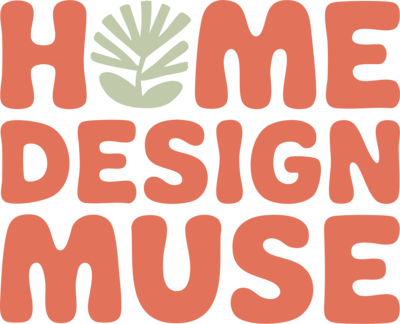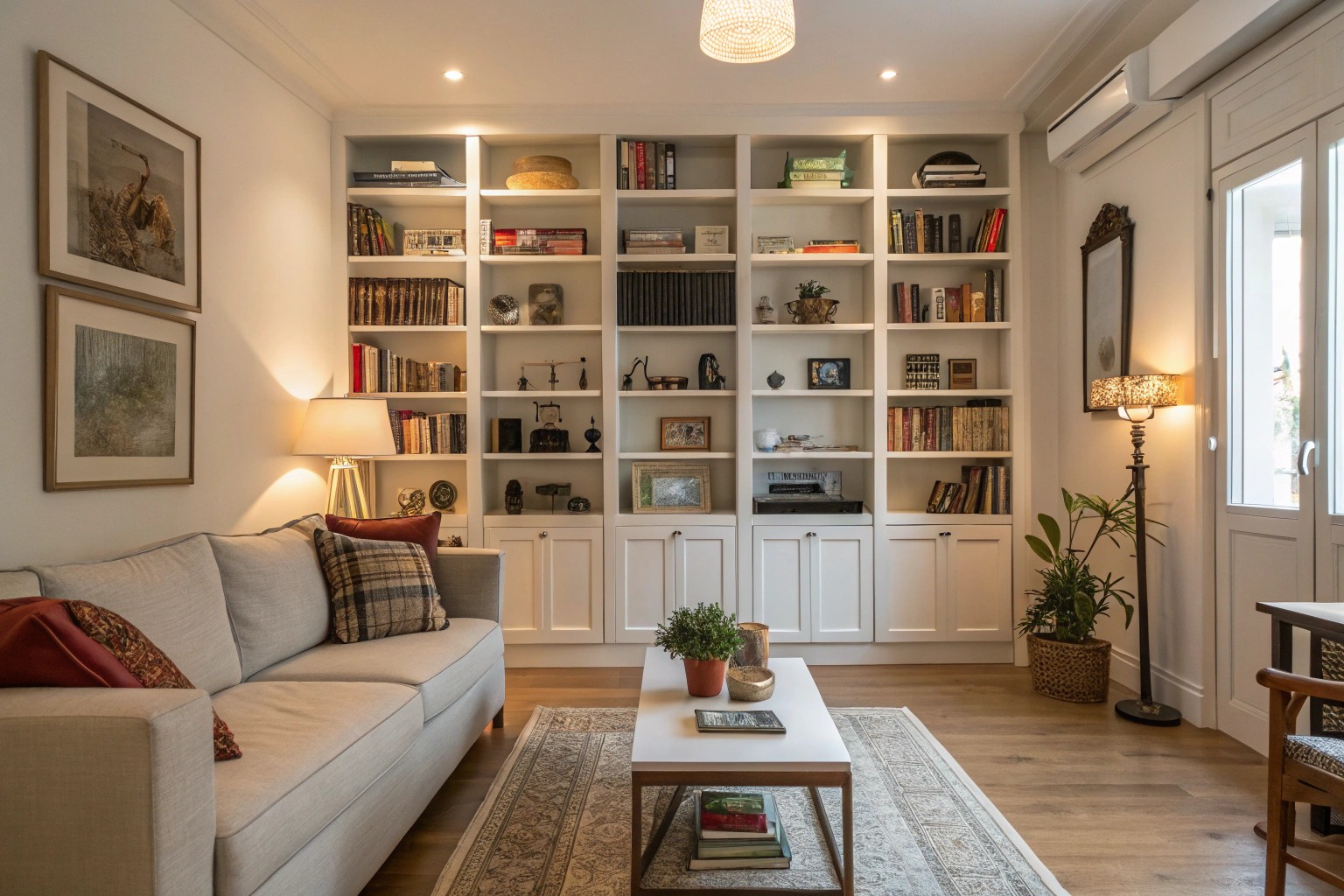Creating shelves that showcase meaningful objects requires more than simply arranging items by size or color. When we thoughtfully curate displays that honor the stories behind our treasured possessions, we transform functional storage into deeply personal galleries that reflect our authentic selves and the journeys that have shaped us.
Understanding the Psychology of Object Display
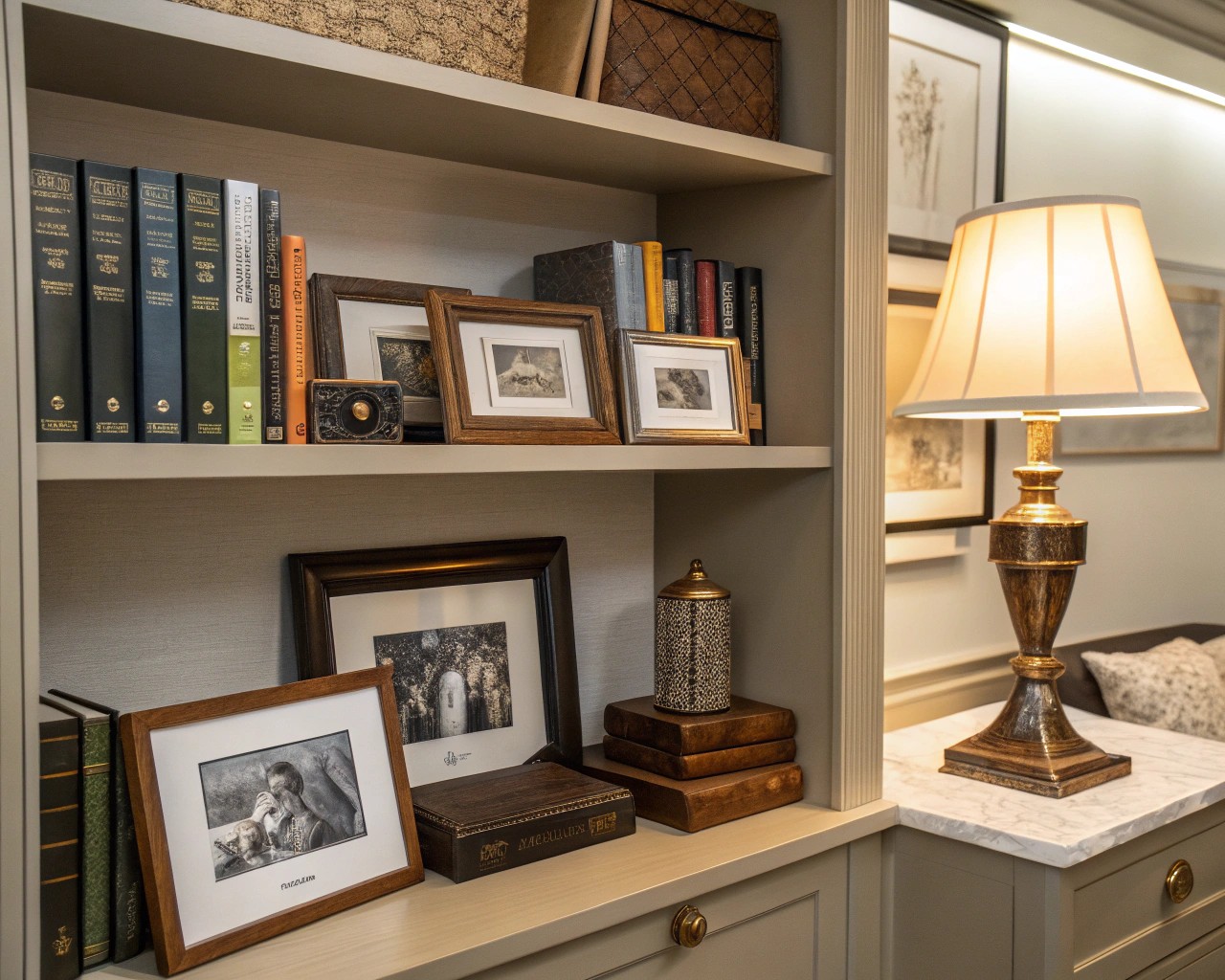
The way we arrange meaningful objects profoundly influences how we experience our living spaces. Sentimental items serve as visual anchors that ground us in memories, relationships, and significant life moments. Rather than hiding these treasured pieces in storage boxes, strategic shelf styling allows us to integrate them seamlessly into our daily environments.
Research in environmental psychology suggests that spaces filled with personally meaningful objects contribute to a stronger sense of identity and emotional well-being. When styling shelves with emotional value, we’re not simply decorating—we’re creating visual narratives that reinforce our connections to people, places, and experiences that matter most.
The challenge lies in balancing the desire to display everything we cherish with the need for visual coherence and functional living spaces. Professional designers consistently recommend a curation-first approach, where selecting fewer, more meaningful pieces creates greater impact than overwhelming displays.
Establishing Your Narrative Foundation
Creating Visual Hierarchy Through Storytelling
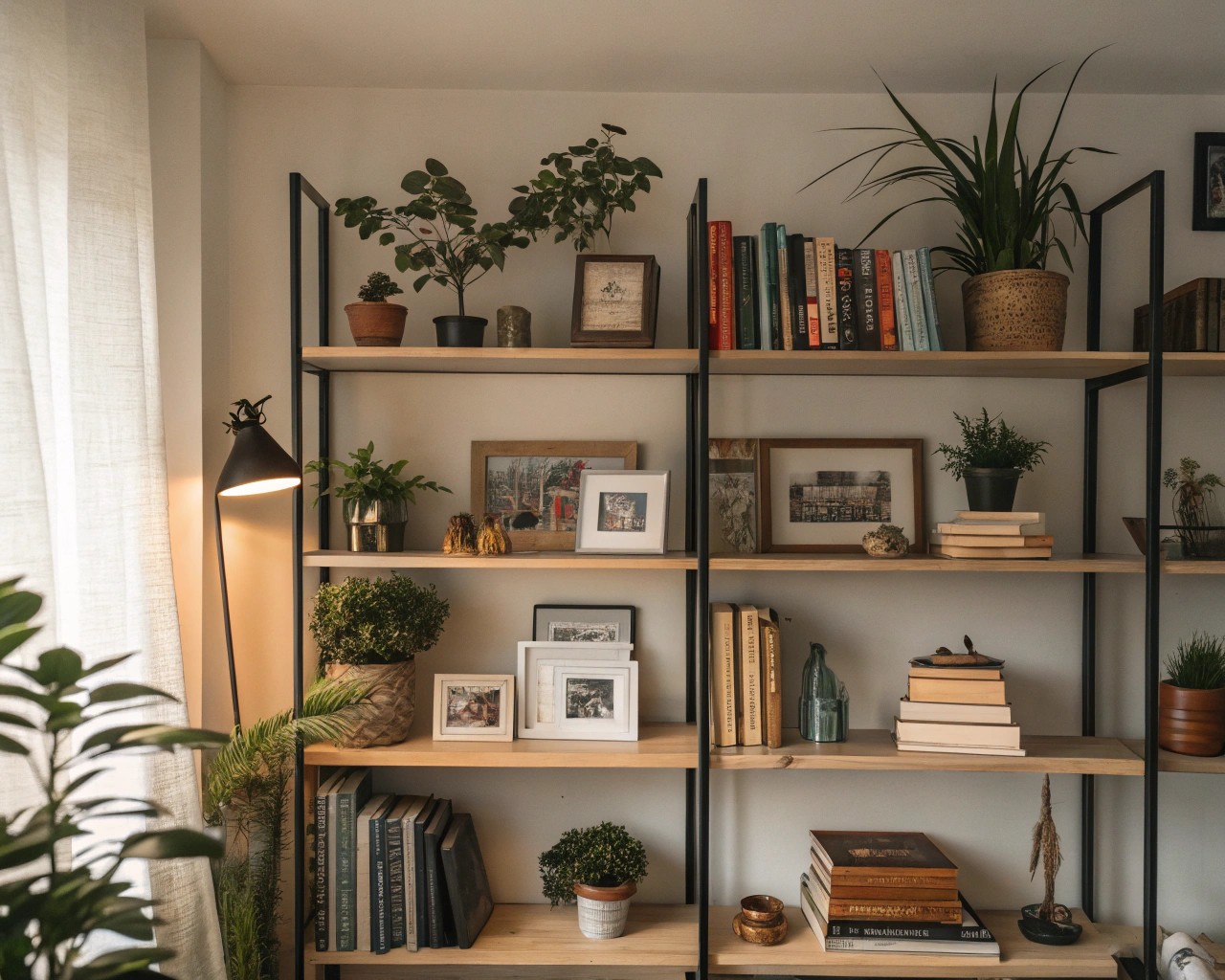
Before placing any objects, establish a clear narrative framework for your shelves. Consider organizing by themes such as travel memories, family heritage, artistic pursuits, or life milestones. This thematic approach ensures that even diverse objects feel intentionally connected rather than randomly assembled.
I’ve found that clients achieve the most satisfying results when they begin by identifying three to five core stories they want their shelves to tell. For example, one section might celebrate global adventures through collected ceramics and textiles, while another honors family history through inherited photographs and heirlooms.
Effective narrative categories include:
- Geographic journeys and cultural connections
- Family legacy and generational ties
- Personal growth and achievement milestones
- Artistic influences and creative inspirations
- Seasonal celebrations and traditions
The Editing Process: Selective Curation
The foundation of compelling shelf styling lies in thoughtful editing. Professional designers recommend displaying only 30-40% of your meaningful objects at any given time. This selective approach allows each piece to receive proper visual attention while maintaining the flexibility to rotate displays seasonally or as new meaningful objects enter your collection.
Start by gathering all potential display items and grouping them by emotional significance rather than physical characteristics. The most impactful pieces—those that immediately evoke strong memories or represent pivotal life moments—should form the core of your display. Secondary items can provide supporting context or be reserved for future rotations.
Technical Principles of Meaningful Display
The Triangle Method for Emotional Balance
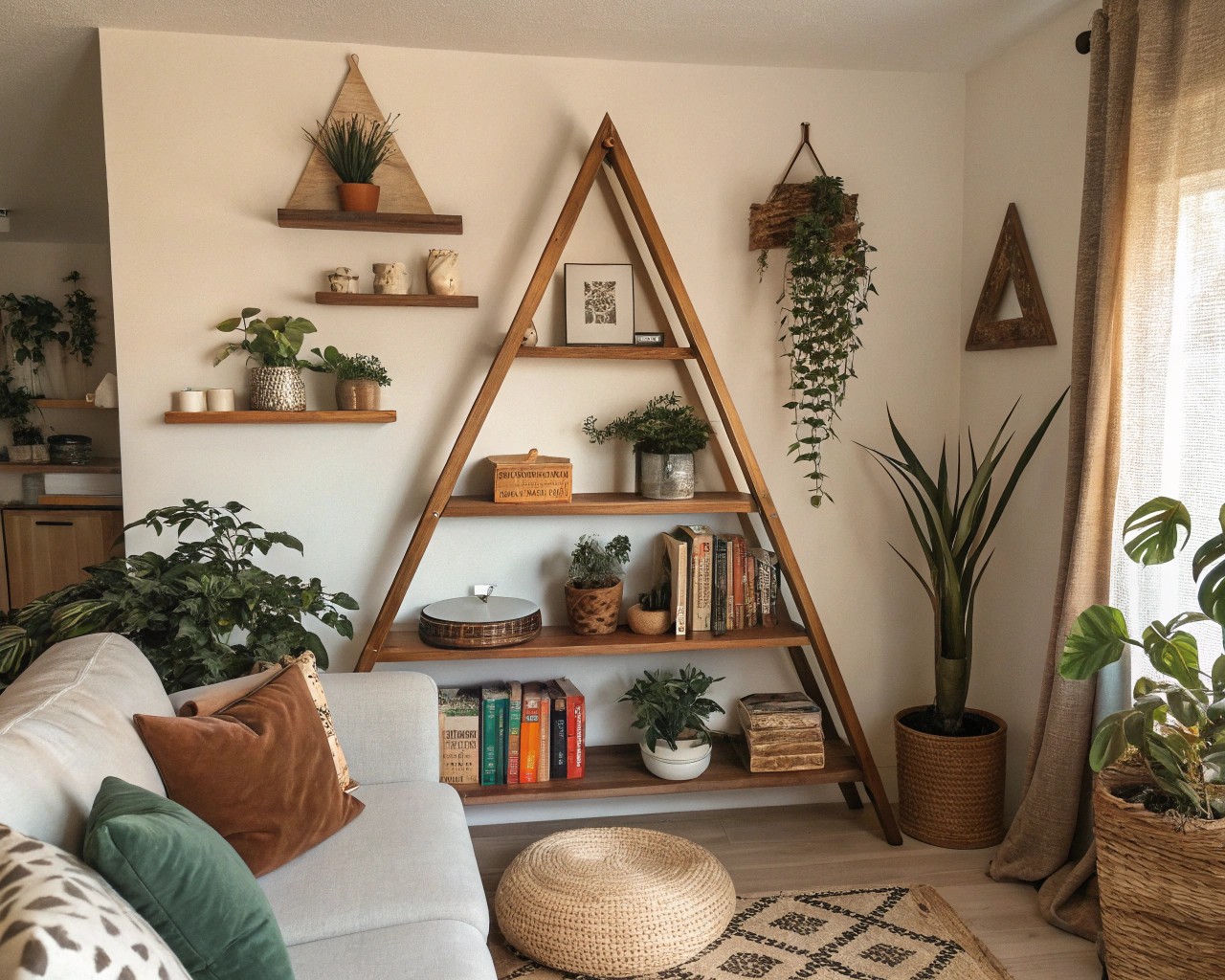
Professional designers frequently employ the triangle method for creating visually pleasing arrangements that feel naturally balanced. This technique involves positioning objects of varying heights to form triangular compositions, which the human eye processes as inherently stable and harmonious.
When working with sentimental objects, start with your tallest or most significant piece as the triangle’s apex, typically positioned toward the back of the shelf. Two smaller, complementary objects form the triangle’s base, creating visual weight distribution while maintaining narrative coherence.
Practical triangle applications:
- Heritage Display: Antique family clock (apex) paired with vintage photographs and inherited jewelry box (base)
- Travel Collection: Large ceramic vase from Italy (apex) with smaller pottery pieces from different regions (base)
- Achievement Grouping: Framed diploma or award (apex) accompanied by related books and symbolic objects (base)
Layering for Dimensional Storytelling

Creating depth through strategic layering allows multiple story elements to coexist without competing for attention. Professional staging techniques involve working with three distinct depth planes: background anchors, middle-ground focal points, and foreground details.
Background elements typically include larger, more substantial pieces that provide visual weight and context. Framed artwork, substantial books, or larger inherited objects work well in this capacity. The middle ground accommodates primary decorative objects—the pieces that carry the strongest emotional resonance and deserve prominent placement.
Foreground elements consist of smaller, detail-oriented objects that invite closer inspection. These might include delicate jewelry, small photographs, or collected stones that hold special meaning but require intimate viewing to appreciate fully.
Strategic Object Integration
Incorporating Books as Narrative Foundations
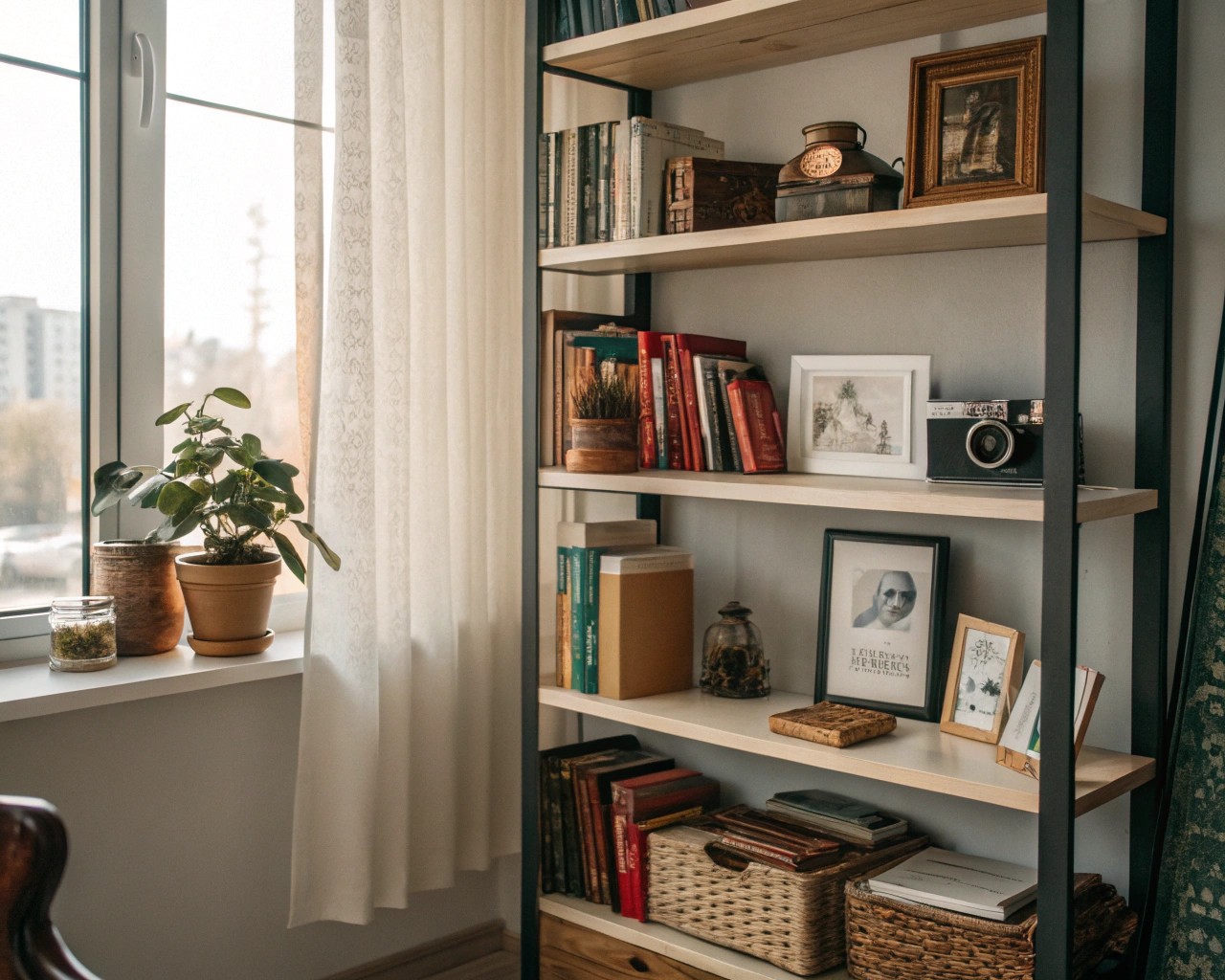
Books serve dual functions in meaningful shelf displays—they provide both practical elevation platforms and thematic context for associated objects. Stack books horizontally to create stable bases for displaying delicate items while ensuring the book subjects relate to your overall narrative themes.
A photography book from your honeymoon destination can elevate a small souvenir while reinforcing the travel theme. Similarly, art books provide appropriate foundations for inherited jewelry or small sculptures, creating logical connections between displayed elements.
Effective book integration strategies:
- Use coffee table books as risers for small, precious objects
- Arrange books by color to create visual continuity
- Mix vertical and horizontal orientations for dynamic rhythm
- Select book covers that complement rather than compete with displayed objects
Balancing Scale and Proportion
Understanding scale relationships ensures that no single object overwhelms the narrative or disappears entirely within the composition. The general rule involves distributing visual weight across three size categories: large anchor pieces, medium supporting objects, and small detail elements.
Large anchor pieces should represent approximately 30% of your display items but occupy 50-60% of the visual weight. These substantial objects provide stability and confidence to the overall arrangement while serving as primary story focal points.
Medium objects fill supporting roles, creating transitions between large anchors and small details while providing opportunities to introduce complementary colors, textures, or themes. Small objects add personality and intimate details that reward closer examination.
Material and Texture Coordination
Creating Tactile Narratives
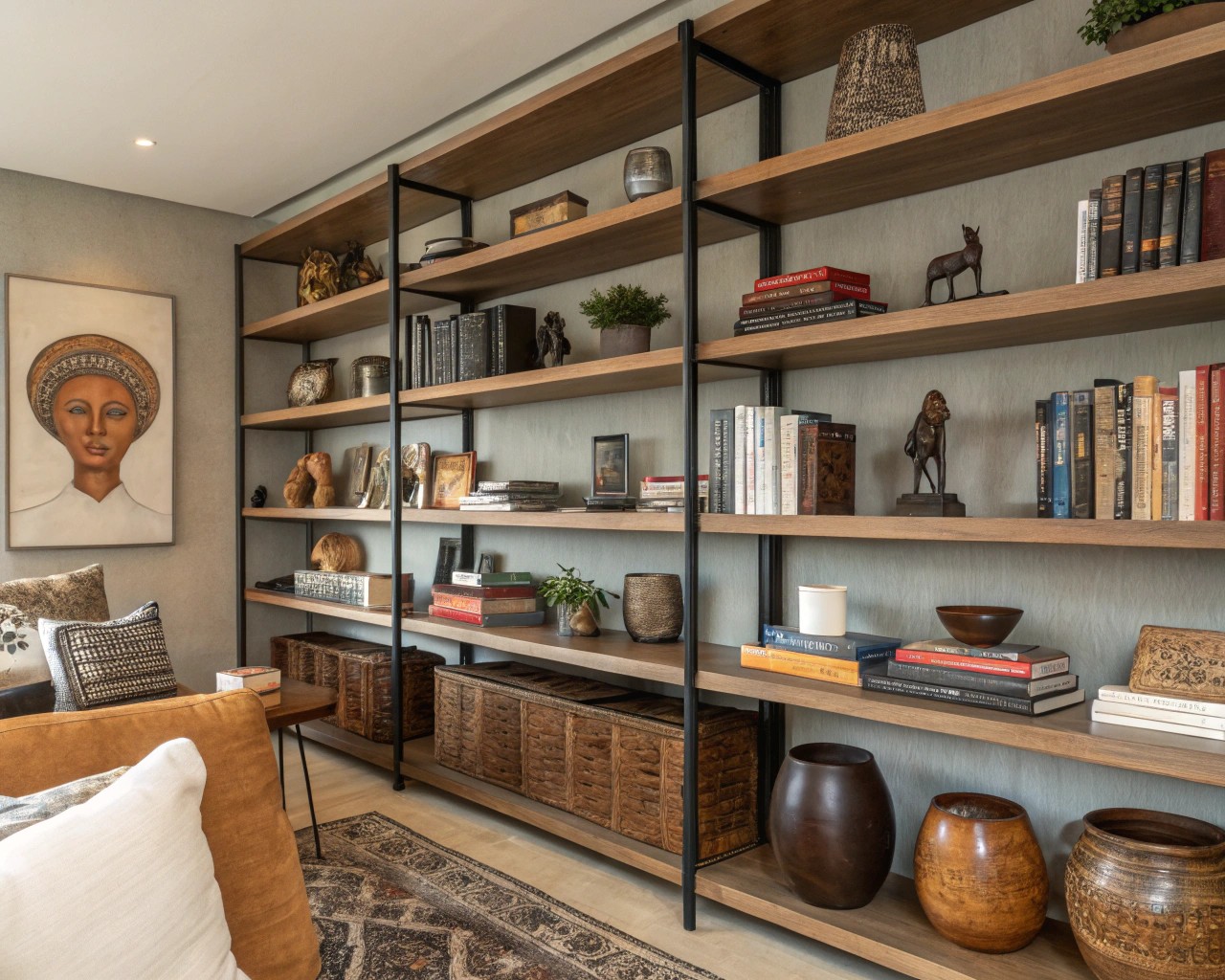
Mixing textures intentionally enhances the sensory experience of meaningful displays while reinforcing emotional connections. Smooth ceramics paired with rough-hewn wood, or polished metals contrasted with soft textiles create dynamic visual interest that mirrors the complexity of our life experiences.
When selecting objects for display, consider how different materials relate to the stories you’re telling. A hand-woven basket from your grandmother might pair beautifully with modern ceramics, creating a bridge between past and present that enriches both elements.
Texture mixing guidelines:
- Combine smooth and rough surfaces for visual contrast
- Use organic materials (wood, stone, fiber) to soften manufactured objects
- Introduce metallic accents sparingly for sophistication
- Balance matte and glossy finishes for depth
Color Psychology in Personal Displays
Color choices profoundly influence how we emotionally respond to displayed objects. Warm colors (reds, oranges, golds) create intimate, welcoming atmospheres that encourage close interaction with meaningful pieces, while cool colors (blues, greens, silvers) provide calming backdrops that allow objects to speak for themselves.
Rather than forcing all objects into matching color schemes, focus on creating harmonic color relationships that feel naturally evolved. Objects collected over time rarely match perfectly, and this organic color variation often produces more interesting and authentic displays than perfectly coordinated arrangements.
Practical Implementation Strategies
The Four-Step Styling Process
Step 1: Clear and Clean
Begin with completely empty, thoroughly cleaned shelves. This blank canvas approach allows you to see the actual space you’re working with and prevents unconscious bias from existing arrangements.
Step 2: Establish Anchor Points
Place your largest, most significant objects first, distributing them across different shelf levels to create visual balance. These anchors will determine the overall rhythm and scale of your final arrangement.
Step 3: Build Supporting Groups
Add medium-sized objects in groups of three or five, creating small vignettes around your anchor pieces. Odd-numbered groupings feel more natural and dynamic than even arrangements.
Step 4: Layer in Details
Introduce small objects, books, and fine details that complete your narratives without overwhelming the primary focal points.
Seasonal Rotation and Refreshing
Meaningful shelf displays benefit from periodic refreshing to prevent visual fatigue and accommodate new acquisitions. Plan for seasonal rotations that align with natural life rhythms: holiday decorations, vacation souvenirs, or milestone achievements.
Create a simple storage system for non-displayed items, organizing by season, theme, or emotional significance. This rotation system ensures that all your meaningful objects receive display time while maintaining fresh, dynamic shelf presentations throughout the year.
Common Challenges and Solutions
Managing Overwhelming Collections
Many people struggle with too many meaningful objects competing for limited display space. The solution involves creating a hierarchical system based on current life priorities and emotional resonance rather than attempting to display everything simultaneously.
Consider implementing a three-tier system: primary objects that remain displayed year-round, secondary objects that rotate seasonally, and tertiary pieces that appear for special occasions or personal milestones. This approach honors all your meaningful possessions while maintaining visually coherent displays.
Integrating Mismatched Inherited Items
Family heirlooms and inherited objects often present styling challenges due to mismatched styles, scales, or conditions. Focus on emotional connections rather than perfect aesthetic coordination. A grandmother’s silver brush might not match your modern aesthetic, but displaying it near contemporary silver accents creates visual bridges while honoring the family connection.
Integration strategies for inherited pieces:
- Group dissimilar inherited items together to create intentional “heritage zones”
- Use consistent display methods (similar frames, uniform lighting) to unify diverse objects
- Pair inherited pieces with contemporary objects in similar materials or colors
- Create narrative labels or small cards explaining the stories behind inherited objects
Long-term Maintenance and Evolution
Preventing Display Fatigue
Even the most carefully curated displays can become visually stagnant over time. Introduce subtle changes quarterly by shifting object positions, adjusting lighting, or swapping one or two pieces for alternatives from your stored collection.
Document your favorite arrangements through photography before making changes. This visual record helps you recreate successful displays and track the evolution of your styling preferences over time.
Incorporating New Meaningful Objects
As life progresses, new meaningful objects naturally enter our collections. Establish criteria for inclusion based on emotional significance, visual compatibility, and available space rather than simply adding every new acquisition.
When introducing new pieces, consider what they might replace rather than simply adding to existing displays. This editing process ensures that your shelves continue telling your most current and relevant stories rather than becoming museums of past experiences.
